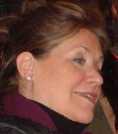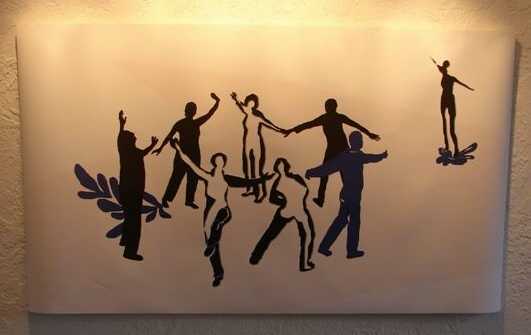FRANCINE
HÉBERT'S

CREATIVE
PIXELS
by
Lydia Schrufer
I
remain amazed and chastened because I had a preconceived bias
about computer art and couldn’t have been more wrong.
Computer generated art is supposed to be, I wrongly judged,
slick, cold, contrived and impersonal. Photoshop art seemed
so far removed from the sensual and organic touch of the artist’s
hand. That was before I saw the work of Francine Hébert.
Francine’s
work, although manipulated with Photoshop, maintains all the
depth and sensuality that have always been present in her painted
works. Since until quite recently she had been using the traditional
methods of drawing, painting, printmaking and sculpture in the
production of her art, I wanted to know why she embarked on
a totally different and technically challenging direction.
During
a recent visit to her studio, I asked Francine why, after years
of success with traditional methods, she decided to employ computer
bytes instead of a brush to create her art.
FRANCINE
HEBÉRT: My decision was based on physical considerations
when after a cancer I had to re-evaluate my life and my method
of working. Although I now have a clean bill of health, the
illness left me much weaker and less able to spend long energy-draining
hours on my feet. The physicality of my way of working just
wasn’t possible anymore. Art making is vital to my being,
it creates my universe, but my main consideration had to be
healing and making art had to be part of the healing process.
I just didn’t know how I would be able to reconcile those
two needs.

LYDIA
SCHRUFER: Are you still using similar source material that you
used for your previous work or did you have to change your focus
to accommodate the new technique?
FRANCINE
HEBÉRT: The intentions of my work have remained fundamentally
constant; only the treatment differs. This most recent work
is my reaction to a walk I took during my convalescence, amidst
an apple orchard whose venerable old trees I always called the
sentinels. Those trees, despite being gnarled and wind blown,
had withstood decades and were thriving. Just a short week after
that walk I went back to that orchard and to my horror all the
trees had been felled to make room for a new orchard planting.
I was devastated to see those mangled old trunks and roots;
it was as if everything there had been subjected to torture.
The experience evoked a feeling of emptiness and I drew the
analogy with my own fragile combat to survive. I recorded the
destruction with my camera and I knew I had found a powerful
subject for future paintings. I also knew it would be a long
time before I would be strong enough to do anything about those
images which have become my personal homage to the fragility
of nature, where a whole universe can be revealed in the rings
of a tree trunk. The catalyst that would solve my problem was
a fortuitous meeting with a professor of digital art who is
himself an artist. He opened my eyes to the possibility of ‘painting’
with a computer. I have to say that I was skeptical at first.

LS:
Nature has always played an important role in your work, featuring
organic layerings and textures. Is that aspect difficult to
maintain?
FRANCINE
HEBÉRT: Actually, I always used the paint in a sculptural
way. I would approach the canvas in a very tactile way, in effect
sculpting with paint, which is what I’m now doing with
the computer. My approach is still sculptural, and as it turns
out the Photoshop tools offer infinite possibilities and lend
themselves perfectly to achieve the effects I’m looking
for. That discovery is a big relief.

LS:
What has your biggest challenge been so far? It can’t
be as easy as all that to change your whole approach to art
making.
FRANCINE
HEBÉRT: The biggest and most arduous challenge has been
to not only learn Photoshop, but to keep at it when it can be
so frustrating.
LS:
What can you tell us of the advantages and perhaps disadvantages
of computer versus ‘brush and canvas’?



FRANCINE
HEBÉRT: In my case I only see advantages. Working with
the computer allows me to keep expressing myself creatively
and it suits my energy right now. Throughout my career I’ve
often felt frustrated because I felt I was unable to adequately
transmit my ideas. I’ve always wanted to explore more
profoundly, to be able to make concrete the deep feelings of
wonder and awe I felt for nature, and to be able to transmit
that vision. I was often frustrated with the limitations of
my materials. But now I’ve found a medium that, with a
few clicks of the mouse, produces the effects and feelings I
wish to capture. I know that makes this project sounds so effortless.
What I should say is with thousands of finger cramping clicks
of the mouse.
Right
now I’m actually trying to sculpt a three dimensional
image out of a two dimensional photo trapped in my computer
which makes the computer my tool. Another problem that I am
learning to solve is the consideration of scale. What I mean
by that is try to imagine the relatively small format of the
image on the computer screen having to be enlarged to almost
life size. I want the finished works to be large enough to allow
the viewer to interact with the image and reflect on his or
her physical space in relation to nature. The artwork might
look fantastic on the screen but once printed many times that
size the work might lose some or all of its original power --
which means I have to begin again from scratch, spending many
intense hours in front of the screen, cursing, stamping my feet
and even on occasion tearing my hair out. On the other hand,
there is no greater satisfaction than when it all comes together
and, once enlarged and printed, the image evokes exactly the
emotional reaction you intended it to have. I’m not saying
that I’ll never go back to my beloved brushes, but for
now I’m immersed in the possibilities of this new discovery.
Francine
Hébert is presently working on a project that will be
exhibited at the end of 2007 or beginning 2008.